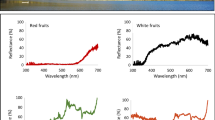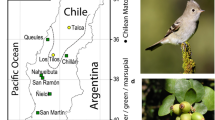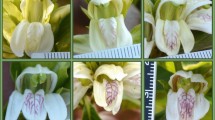Abstract
Fruit colour polymorphisms are widespread in nature, but their ecological and evolutionary dynamics remain poorly understood. Here we examine Acacia ligulata, a shrub of the Australian arid zone which exhibits a red/orange/yellow aril colour polymorphism. We asked whether the polymorphism had a genetic basis; whether selection acted differentially on morphs during the seed and seedling stages; whether geographic variation in morph frequencies was correlated with environmental factors; and whether morphs differed in physical or chemical characteristics that might influence selection on them. When grown to maturity in a common greenhouse environment, maternal families of seeds showed phenotypic patterns consistent with biparental genetic control of the polymorphism. In contrast to other fruit-colour polymorphic species, progeny of A. ligulata morphs did not vary in rates of seedling emergence or survival in a common garden. Sampling along a 580 km transect revealed clinal variation in morph frequencies. Frequencies of the yellow morph decreased, and frequencies of the red morph increased, across a gradient of decreasing temperature and increasing rainfall. Morphs did not differ in seed mass, aril mass, or in profiles of fatty acids and flavonoids in either arils or seeds. However, morphs showed consistent differences in carotenoid profiles' and elemental content of arils, suggesting that selection by avian and insect seed dispersers, seed predators and herbivores should be investigated. These patterns indicate that both abiotic and biotic factors may contribute to selection on the A. ligulata polymorphism.
Similar content being viewed by others
References
Auld, T.D. (1995a) Soil seedbank patterns of four trees and shrubs from arid Australia. J. Arid Env. 29, 33–45.
Auld, T.D. (1995b) The impact of herbivores on regeneration in four trees from arid Australia. Rangeland J. 17, 213–227.
Auld, T.T. and Denham, A.J. (2001) Flora conservation issues at Kinchega National Park, western NSW. Cunninghamia 7, 27–41.
Britton, G., Liaaen-Jensen, S. and Pfander, H. (1995) Carotenoids today and challenges for the future. In G. Britton, S. Liaaen-Jensen and H. Pfander (eds) Carotenoids. Vol. 1A. Birkhauser Verlag, Basel, pp. 13–26.
Carroll, M., Hanlon, A., Hanlon, T., Zangerl, A.R. and Berenbaum, M.R. (1997) Behavioral effects of carotenoid sequestration by the parsnip webworm, Depressaria pastinacella. J. Chem. Ecol. 23, 2707–2719.
Chapman, A.R. and Maslin, B.R. (1992) Acacia miscellany 5: a review of the A. bivenosa group (Leguminosae: Mimosoideae: Section Phyllodineae). Nuytsia 8, 249–283.
Davidson, D.W. and Morton, S.R. (1984) Dispersal adaptations of some Acacia species in the Australian arid zone. Ecology 65, 1038–1051.
Epling, C. and Dobzhansky, T. (1942) Genetics of natural populations: VI. Microgeographical races in Linanthus parryae. Genetics 27, 317–332.
Feltwell, J. (1978) The distribution of carotenoids in insects. In J.B. Harborne (ed.) Biochemical Aspects of Plant and Animal Coevolution. Academic Press, London, pp. 277–293.
Forde, N. (1986) Relationships between birds and fruits in temperate Australia. In. H.A. Ford and D.C. Paton (eds) The Dynamic Partnership: Birds and Plants in Southern Australia. Government Printer, South Australia, pp. 42–58.
Gervais, J.A., Noon, R.B. and Willson, M.F. (1999) Avian selection of the color-dimorphic fruits of salmonberry, Rubus spectabilis: a field experiment. Oikos 84, 77–86.
Gervais, J.A. Traveset, A. and Willson, M.F. (1998) The potential for seed dispersal by the banana slug (Ariolimax columbianus). Am. Midl. Nat. 140, 103–110.
Gillespie, J.H. (1998) Population Genetics: A Concise Guide. Johns Hopkins University Press, Baltimore.
Goodwin, T.W. and Goad, L.J. (1970) Carotenoids and triterpenoids. In A.C. Hulme (ed.) The Biochemistry of Fruits and Their Products. Vol. 1 Academic Press, London, pp. 305–368.
Groos, C., Gay, G., Perretant, M.-R., Gervais, L., Bernard, M., Dedryver, F. and Charmet, G. (2002) Study of the relationship between pre-harvest sprouting and grain color by quantitative trait loci analysis in a whitexred grain bread-wheat cross. Theor. Appl. Genet. 104, 39–47.
Harding, J. and Barnes, K. (1977) Genetics of Lupinus. X. Genetic variability, heterozygosity and outcrossing in colonial populations of Lupinus succulentus. Evolution 31, 247–255.
Hedrick, P.W. (1986) Genetic polymorphism in heterogeneous environments: a decade later. Ann. Rev. Ecol. Syst. 17, 535–566.
Hill, G.E. (2002) A Red Bird in a Brown Bag: The Function and Evolution of Colorful Plumage in the House Finch. Oxford University Press, New York.
Hintze, J. (2002) PASS. Number Cruncher Statistical Systems, Kaysville, Utah, USA.
Huh, J.H., Kang, B.C., Nahm, S.H., Kim, S., Ha, K.S., Lee, M.H. and Kim, B.D. (2001) A candidate gene approach identified phytoene synthase as the locus for mature fruit color in red pepper (Capsicum spp.). Theor. Appl. Genet. 102, 524–530.
Kayser, H. (1985) Pigments. In G.A. Kerkut and L.E. Gilbert (eds) Comparative Insect Physiology, Biochemistry, and Pharmacology. Vol. 10. Academic Press, New York, pp. 368–415.
Lefebvre, V., Kuntz, M., Camara, B. and Palloix, A. (1998) The capsanthin-capsorubin synthase gene: a candidate gene for the y locus controlling the red fruit colour in pepper. Plant Mol. Biol. 36, 785–789.
Letnic, M., Dickman, C.R. and McNaught, G. (2000) Bet-hedging and germination in the Australian arid zone shrub Acacia ligulata. Aust. Ecol. 25, 368–374.
Levey, D.J. and Martinez del Rio, C. (2001) It takes guts (and more) to eat fruit: lessons from avian nutritional ecology. Auk 118, 819–831.
Maslin, B.R. and Hopper, S.D. (1982) Phytogeography of Acacia (Leguminosae: Mimosoideae) in Central Australia. In W.R. Barker and P.J.M. Greenslade (eds) Evolution of the Flora and Fauna of Arid Australia. Peacock Publications, Frewville, South Australia, pp. 301–315.
Mayr, E. (1965) Animal Species and Evolution. Belknap Press, Cambridge, MA, USA.
McGinley, M.A., Temme, D.H. and Geber, M.A. (1987) Parental investment in offspring in variable environments: theoretical and empirical considerations. Am. Nat. 130, 370–398.
Mendel, G. (1865) Experiments in Plant-hybridisation. Harvard University Press Edition, 1941, Cambridge.
Murphy, M.E. (1996) Nutrition and metabolism. In C. Carey (ed.) Avian Energetics and Nutritional Ecology. Chapman and Hall, New York, pp. 31–60.
Nishida, R., Rothschild, M. and Mummery, R. (1994) A cyanoglucoside, sarmentosin, from the Magpie Moth, Abraxas grossulariata, Geometridae: Lepidoptera. Phytochemistry 36, 37–38.
O'Dowd, D.J. and Gill, A.M. (1986) Seed dispersal syndromes in Australian Acacia. In D.R. Murray (ed.) Seed Dispersal. Academic Press, San Diego, California, pp. 87–122.
Olson, V.A. and Owens, I.P.F. (1998) Costly sexual signals: are carotenoids rare, risky, or required? Trends Ecol. Evol. 13, 510–514.
Philippi, T.E. (1993) Multiple regression: herbivory. In S.M. Scheiner and J. Gurevitch, (eds) Design and Analysis of Ecological Experiments. Chapman and Hall, New York, NY, pp. 183–210.
Puckey, H.L., Lill, A and O'Dowd, D.J. (1996) Fruit color choices of captive silvereyes (Zosterops lateralis). Condor 98, 780–790.
Rothschild, M. (1980) Remarks on carotenoids in the evolution of signals. In L.E. Gilbert and P.H. Raven, (eds) Coevolution of Animals and Plants. Revised Edition, University of Texas Press, Austin, pp. 20–50.
Rothschild, M., Mummery, R. and Farrell, C. (1986) Carotenoids of butterfly models and their mimics (Lep: Papilionidae and Nymphalidae). Biol. J. Linn. Soc. 28, 359–372.
SAS Institute (2000) The SAS System for Windows, release 8.1. SAS Institute, Cary, NC, USA.
Scheiner, S.M. (1993) MANOVA: multiple response variables and multispecies interactions. In S.M. Scheiner and J. Gurevitch, (eds) Design and Analysis of Ecological Experiments. Oxford University Press, Oxford, pp. 94–112.
Sharma, S. (1996) Applied Multivariate Techniques. Wiley, New York.
Sheppard, P.M. (1951) Fluctuations in the selective value of certain phenotypes in the polymorphic land snail Cepea nemoralis. Heredity. 5, 125–134.
Simms, E.L. and Bucher, M.A. (1996) Pleiotropic effects of flower-color intensity on herbivore performance on Ipomoea purpurea. Evolution 50, 957–963.
Traveset, A., Riera, N. and Mas, R.E. (2001) Ecology of fruit-color polymorphism in Myrtus communis and differential effects of birds and mammals on seed germination and seedling growth. J. Ecol. 89, 749–760.
Traveset, A. and Willson, M.F. (1998) Ecology of the fruit-colour polymorphism in Rubus spectabilis. Evol. Ecol. 12, 331–345.
Whitney, K.D. (2002) Dispersal for distance? Acacia ligulata seeds and meat ants Iridomyrmex viridiaeneus. Austral Ecol. 27, 589–595.
Whitney, K.D. (2003) Evolutionary ecology of seed predation and seed dispersal in a polymorphic acacia. Ph.D. Dissertation, University of California, Davis, California.
Willson, M.F. (1986) Avian frugivory and seed dispersal in eastern North America. Curr. Ornithol. 3, 223–279.
Willson, M.F. (1994) Fruit choices by captive American robins. Condor 96, 494–502.
Willson, M.F. and Comet, T.A. (1993) Food choices by northwestern crows: experiments with captive, free-ranging and hand-raised birds. Condor 95, 596–615.
Willson, M.F. and O'Dowd, D.J. (1989) Fruit color polymorphism in a bird-dispersed shrub (Rhagodia parabolica) in Australia. Evol. Ecol. 3, 40–50.
Willson, M.F. and Whelan, C.J. (1990) The evolution of fruit color in fleshy-fruited plants. Am. Nat. 136, 790–809.
Willson, M.F., Irvine, A.K. and Walsh, N.G. (1989) Vertebrate dispersal syndromes in some Australian and New Zealand plant communities, with geographic comparisons. Biotropica 21, 133–147.
Willson, M.F., Rice, B.L. and Westoby, M. (1990) Seed dispersal spectra: a comparison of temperate plant communities. J. Veg. Sci. 1, 547–562.
Author information
Authors and Affiliations
Corresponding author
Rights and permissions
About this article
Cite this article
Whitney, K.D., Lister, C.E. Fruit colour polymorphism in Acacia ligulata: seed and seedling performance, clinal patterns, and chemical variation. Evolutionary Ecology 18, 165–186 (2004). https://doi.org/10.1023/B:EVEC.0000021153.64497.c1
Issue Date:
DOI: https://doi.org/10.1023/B:EVEC.0000021153.64497.c1




